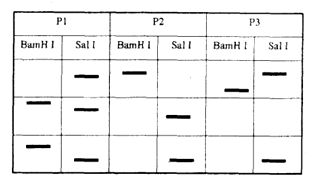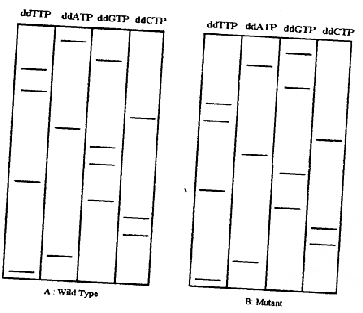 Multiple Choice Questions
Multiple Choice QuestionsNumber of trials required for rats to learn a task when they were exposed to various condition were as follows:
| Experimental conditions | Observations |
|
A. Light: light dark cycle – 12h: 12h |
N – trials |
| B. Bright light – 24 h |
Significantly more trials than ‘N’ |
| C. Bright light – 24 h + continuous physical disturbance |
Significantly more trials than ‘N’ |
| D. Dark light – 24 h + continuous physical disturbance |
Significantly more trials than ‘N’ |
Which of the following inferences is most appropriate?
Continuous light enhanced learning
Continuous darkness inhibited learning
Physical activity inhibited learning
Learning was reduced by sleep loss
D.
Learning was reduced by sleep loss
Among the given options, learning was reduced by sleep loss is the most appropriate inference.
Assume a male sparrow (species X) is hatched and reared in isolation and allowed a critical imprinting period to hear the song of a male of another sparrow (species Y). Now after the isolation, what kind of behavior will species X show?
It will sing the sing of species Y that it had heard in the critical period.
It will sing the song of its own species X.
It will not sing at all.
It will sing a song not sung by either X or Y.
Enzymes are nowadays used extensively in bioprocessing industries. Enzyme 1 is used for treatment of hides to provide a finer texture, in leather processing and manufacture of glue. Enzyme 2 is used for clarification of fruit juices.
Identify enzyme 1 and 2
Enzyme 1- Amylase; Enzyme 2- Pectinase
Enzyme 1- Protease; Enzyme 2- Amylase
Enzyme 1- Protease; Enzyme 2- Pectinase
Enzyme 1- Pectinases; Enzyme 2- Amylase
In order to prevent tetanus in neonates, one of the following treatments can be adopted.
A. Treatment of the infant with anti-toxin and the toxoid,
B. Immunize of the mother with the toxoid.
In case of A, the treatment can be given
a. immediately after birth
b. after the onset of the condition.
In case of B, the immunization has to be done
c. before pregnancy
d. late in the pregnancy.
The correct combination is
A/ a
A/ b
B/ c
B/ d
Genomic DNA of transgenic plants (P1, P2 and P3 obtained by transforming with binary vector A whose map is depicted below, was digested with BamH I and Sal I and hybridized with a labeled fragment X

The pattern obtained in Southern hybridization is shown below:

Based on the above, which of the following interpretations is correct:
All the plants (P1, P2 and P3) contain two copies of the transgene.
P1, P3 contain one and P2 contains two copies of the transgene.
P1 contains two, whereasP2 and P3 contain one copy of transgene each.
P1 and P2 contains two and P3 contains one copy of the transgene.
The following are statements about molecular markers in the context of plant breeding.
A. Molecular markers can be used for elimination of undesirable traits.
B. Molecular markers cannot be used for estimation of the genetic contribution of each individual parent in a segregating population.
C.molecular markers are used for mapping of QTLs, which is also possible by conventional techniques.
D. Molecular markers can be used for selection of individuals from a population that are homozygous for the recurrent genotype at loci flanking the target locus.
Which of the above statements are TRUE?
A and B
A and C
A and D
B and C
In ‘TaqMan’ assay for detection of base substitutions (DNAvariant), probes (oligonucleotides) with fluorescent dyes at the 5’-end and a quencher at 3’-end are used. While the probe is intact, the proximity of the quencher reduces the fluorescence emitted by reporter dye. If the target sequences (wild type or the variant) are present, the probe anneals to the target sequence, down stream to one of the primers used for amplifying the DNA sequence flanking the position of the variants. For an assay two flanking PCR primers, two probes corresponding to the wild type and variant allele and labeled with two different reporter dyes and quencher were used. During extension the probe may be cleaved by the Taq-polymerase separating the reporter dye and the quencher. Three individuals were genotyped using this assay. Sample for individual I shows maximum fluorescence for the dye attached to the wild type probe, sample for individual II shows maximum fluorescence for the dye attached to variant probe and sample for individual III exhibits equal fluorescence for both the dyes. Which of the following statement is correct?
Individual I is homozygous for the variant allele
Individual II is homozygous for variant allele.
Individual II is homozygous for wild type allele.
Individual III is homozygous for wild type allele.
Stem cell therapies are being used in regenerative medicine like forming new adult bone, which usually does not regrow to bridge wide gaps. Successful attempts have now been made in this area because the same paracrine and endocrine factors were found to be involved in both endochondral ossification and fracture repair. Few methods to achieve the above are given below:
A. Develop a collagen gel containing plasmids carrying the human parathyroid hormone gene and place in the gap between the ends of the broken leg.
B. Develop a gel matrix disc containing genetically modified stem cells to secrete BMP4 and VEGF-A and implant it at the site of the wound.
C. Make scaffolds of material that resemble normal extracellular matrix that could be molded to form the shape of a bone needed and seed them with bone marrow stem cell.
D. develop a collagen gel containing plasmids carrying the human bone marrow cells and place them between the ends of the bones.
Which of the above methods would you employ to develop a new functional bone in patients with severely fractured bones?
A and B
A, B and C
A and C
C and D
Cre/ lox P system is used by phage P1 to remove terminally redundant sequences that arise during packaging of the phage DNA. Cre-lox system can be used to create targeted deletions, insertions and inversion in genomes of transgenic animals and plants. Consider a series of genetic markers A to K. How should the Lox-P sites be positioned in order that Cre recombinase can create an inversion in the EFG segment relative to ABCD and HIJK?
![]()
![]()
![]()
![]()
Figures A and B respectively represent the dideoxy sequencing gels obtained for partial sequences from 5’- ends of a bacterial gene and its mutant (wih a point mutation).

What type of mutation has occurred in the gene?
Non-sense
Mis-sense
Frameshift
Transversion
